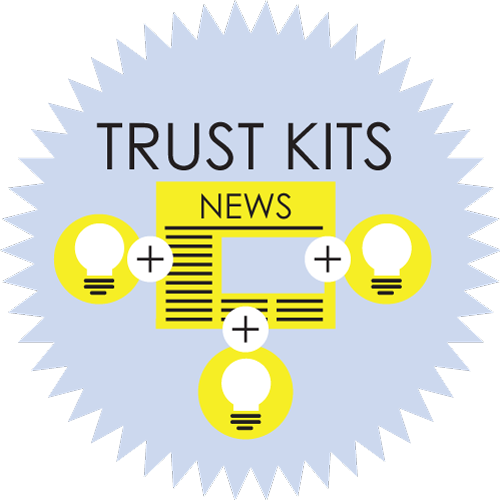FOR EDUCATORS
Today’s journalism educators are sending students into a complicated media landscape. These Trusting News Educator Trust Kits will give you research-backed strategies to help prepare students to build trust with communities. The kits have been designed to help students learn about the media and how news works while preparing students for work in a newsroom or other information-sharing position. Learn more about our goals with these kits and how to best use them here.
How to listen & respond to your community (ADVANCED)
As a journalist, you’re bound to receive some complaints or criticism about your work and you can’t make everyone happy all the time.
The key is how you respond — and it’s important to use humility and diplomacy while not being afraid to explain and defend your work.
On top of responding, creating regular listening opportunities can help you better serve your communities and build trustworthy relationships with them.
Start with the basics: This is an advanced lesson best for higher level or more advanced journalism students who have some experience with reporting. If you’re just broaching the subject of outreach and listening with your students, we recommend you start with this Educator Trust Kit, How engaging and listening can build trust.
Help students think of comments and user interactions as opportunities to improve news content and build trust

Learning objectives
- Develop the skills of seeking input from their audience and addressing their questions
- Explore strategies to foster regular interaction with their communities, emphasizing the importance of active listening and creating accessible channels for community members
- Learn from real-world examples of successful audience engagement and community-focused journalism
- Practice how to have conversations with news consumers driven by curiosity, not defensiveness
- Understand and practice how to best ask the community for feedback

Using this in your classroom
Here are two curriculum outlines based on the provided learning objectives and in-class activities – all of which you’ll find in this Trust Kit. These curriculum outlines can be adjusted as needed to fit specific time constraints and student needs.
Expand each of the following blue boxes by clicking or tapping the + sign.
Classroom agenda: 50 minute class
-
Assign students to review the following training materials before class: Advice from journalists: Why we’ve invested in listening to people who don’t trust us and Want a relationship based on trust? Invest in interactions
- Building Credibility (25 minutes)
- Use the following teaching materials to help students understand the importance of responding and engaging with the community: Comments, civility and defending ourselves
- In-class Activity: Identify the information gap (25 minutes)
- Use the remainder of the class period to complete the in-class activity: Identify the information gap
Classroom agenda: 90 minute class
- Building Credibility (20 minutes)
- Use the following teaching materials to help students understand the importance of responding and engaging with the community: Comments, civility and defending ourselves
- Understanding how to respond to comments (25 minutes)
- Have students read the following training materials before class and lead a discussion based on them: Moderate comments on the conversations you host, How to turn negative feedback into opportunity and A case study: Earning trust by inviting questions and answering them
- In-class Activity: Practice defending journalism (45 minutes)
- Use the remainder of the class period to complete the in-class activity: Invite live social media engagement

Teaching materials
Use the following resources to lead your students through this curriculum. The materials include videos, articles and slideshows. All can be used during class, assigned before class or as part of assignments or discussions. These materials can be supplemented as needed to fit specific time learning objectives and student needs.
Expand each of the following blue boxes by clicking or tapping the + sign.
Student Materials
- Read: Want a relationship based on trust? Invest in interactions (Trusting News)
- Read: Use this language to earn trust face to face (Trusting News)
- Read: A Trusting News tip sheet of language and strategies for engagement (Trusting News)
- Read: Advice from journalists: Why we’ve invested in listening to people who don’t trust us (Trusting News)
- Review: Example of listening and engagement work by newsrooms (Trusting News)
- Read: A case study: Earning trust by inviting questions and answering them (Trusting News)
- Read: Examples: social media callouts (Trusting News)
- Read: How to turn negative feedback into opportunity (Trusting News)
- Read: Investing in interactions (including in the comments) (Trusting News)
- Read: Moderate comments on the conversations you host (Trusting News)
- Watch: How to make time to engage with your audience (Trusting News)
Expert Materials (for educators)
The content below has been selected to help teachers and professors dive deeper and become an expert on the topic.
- Read: Want to reach immigrant communities? Start with listening. (Trusting News)
- Read: How to reach diverse audiences through listening (Trusting News)
- Watch: Engaging with your audience, how to make time for engagement (Trusting News)
- Read:Invite news consumers into your morning meetings (Trusting News)

In-class activities
Below are in-class activities you can use to help your students better understand these topics while gaining deeper knowledge through peer interaction and hands-on learning.
Expand each of the following blue boxes by clicking or tapping the + sign.
In-class activity 1: Identify the information gap
Comments are often the quickest, most frequent ways news consumers respond to journalism. The tone of them can vary quite a bit, but they have a reputation for being toxic and unintelligent. We know, however, that when journalists participate in comments, the tone improves and the perceptions of the credibility of the journalism improves.
Comments also offer an opportunity for journalists to be part of the conversation about their work. Even with someone who’s complaining or being accusatory, when we respond, we reach not just that person but everyone else who’s reading.
One approach to comments is to turn accusations or complaints into information gaps — things people don’t know about how journalism works or what motivates it. Example:
- COMPLAINT: You’re only writing a story about this business because you’re out to get them!
- INFORMATION GAP: Why do journalists find it important to write stories that are critical of local businesses?
- RESPONSE: The health department has found repeated violations at this restaurant that are a matter of public safety. As journalists, one of our jobs is to alert the community to how their government is functioning and also to share information that helps keep people safe. We will be sure to also share when these violations are cleared up. Thanks for commenting.
In pairs or small groups, have students pick three comments or complaints they have received from their news consumers. Instruct the students to practice turning the complaint into an information gap.
Take time to share the transformation from complaint to information gap with the entire class. This will help students improve and master this skill by learning from one another and providing each other with feedback.
In-class activity 2: Invite live social media engagement
For student journalists who have a social media audience for their work (such as through student media), assign them to solicit and answer questions live about their work. This can happen wherever their existing audience can interact with them in real-time (such as Facebook, Instagram or Reddit). It can happen in text only or on video.
Encourage them to brainstorm things they think their audience might be genuinely curious about when it comes to the how and why of their journalism. Start basic. How do you decide what stories to cover? Why do you run columns that make people mad? Do you get free football tickets when you cover the game? Then think about questions you might get and have answers ready. If on camera, have two people ready — one to pose questions and one to answer them. Have a third person ready to monitor comments and feed new questions in. You have no obligation to answer every question, but you should be prepared if tough ones come in.
Let your audience know ahead of time with a post saying when you’ll be live, with an invitation to start leaving questions there. Be ready to follow through whether with a sizable live audience leaving questions or with minimal participation.
As you read through comments, don’t feel obligated to answer everyone. But try to strip away accusatory tones or rudeness. Identify in a more neutral way what someone is asking or suggesting, and answer in good faith.
Consider creating other content after the live event is over. Write a newsletter, column or an FAQ. Talk about it on air and on other social platforms as well.
Resources:

Assignments
Use the below assignments to help student gain a better understanding of the topics while practicing related skills. Each assignment has a printable Google Doc and a grading rubric.
Expand each of the following blue boxes by clicking or tapping the + sign.
Assignment 1: Draft responses to comments
Find a printable Google Doc of the assignment and grading rubric here.
Comments are often the quickest, most frequent ways news consumers respond to journalism. The tone of them can vary quite a bit, but they have a reputation for being toxic and unintelligent. We know, however, that when journalists participate in comments, the tone improves and the perceptions of the credibility of the journalism improves.
Comments also offer an opportunity for journalists to be part of the conversation about their work. Even with someone who’s complaining or being accusatory, when we respond, we reach not just that person but everyone else who’s reading.
One approach to comments is to turn accusations or complaints into information gaps — things people don’t know about how journalism works or what motivates it. Example:
- COMPLAINT: You’re only writing a story about this business because you’re out to get them!
- INFORMATION GAP: Why do journalists find it important to write stories that are critical of local businesses?
- RESPONSE: The health department has found repeated violations at this restaurant that are a matter of public safety. As journalists, one of our jobs is to alert the community to how their government is functioning and also to share information that helps keep people safe. We will be sure to also share when these violations are cleared up. Thanks for commenting.
Practice responding to your own news consumers. Have students look at their own reporting and selection three sample comments or complains they have received.
- Screenshot or paste the comment here, and summarize what the commenter was responding to, if applicable.
- Identify what “information gap” is present. What do you wish this person knew about journalism overall or this piece of journalism specifically?
- Draft a response, considering both the facts and tone of your message.
- Consider collecting the best responses in a document for the staff to refer back to and use as related issues appear in real time.
Assignment 2: Practice defending your journalism
Find a printable Google Doc of the assignment and grading rubric here.
Thanks to Patrick Schmiedt at Citrus College for providing some of the structure for this assignment.
Build upon the “Draft responses to comments” assignment. Have students turn one of their comment responses into a video, longer written explainer or social post that explains and addresses the information gap.
Remember: Journalism is not a box-checking exercise. One size, one approach, does not fit all. Thinking critically about our processes will make us more flexible, accountable and trustworthy journalists.
Some resources for such examples:
- A roundup of formats for transparency: What does transparency in journalism actually look like?
- Collection of newsroom examples: How News Works – Trusting News
- ‘More complete and relatable:’ What research finds about how a TV newsroom can earn trust on air
- Trust 101 for Educators: USC Annenberg case study
Besides text boxes with stories online or in print, consider:
- Incorporating brief “how” and “why” answers into scripts for broadcast
- Creating behind the scenes videos for social media
- Taking audience questions live on Facebook or Instagram (with topics pre-prepared in case engagement is light)
Assignment 3: Create community callouts
Find a printable Google Doc of the assignment and grading rubric here.
Using this guide have students create three social media callouts related to their own reporting or beat.
Here are some themes to consider:
-
What do you wish journalists would cover (but worded in a more user-centric way):
- Generally: What’s something you wish people in the community knew more about?
- On a specific story: We’re covering this topic. What questions should we ask?
- We have two reporters on our Saturday shift trying to decide what to cover. How will you be spending your weekend?
How can we better reflect your life? Things like:
- What do you wish journalists understood about how you see the world?
- What does news coverage often get wrong about things you see in your life?
- We try hard to cover life in our community from diverse angles, but we know there’s plenty we miss. What would you like us to do better at capturing?
What do you know or think about journalism? Things like:
- What questions do you have about how journalism works?
- Have you ever talked to a journalist for a story? What was the experience like?
- How could we better earn your trust? Sample language:
- We know this is a tough time to keep up with the news, and we want to be your most trusted source for information about our community. A shared set of facts and a place to talk about them are core to democracy. We’d love to hear from you: How could we better be worthy of your trust? What questions can we answer about how our newsroom operates?
We’re here to help!
If you have questions about these kits or have used the content in your classroom and have feedback or suggestions, please contact Lynn Walsh, Lynn@TrustingNews.org.
Trusting News would like to thank the Scripps Howard Fund for funding the creation of these kits. We would also like to thank the many educators who have worked with us through the years and inspired this work.
If you would like more resources to bring into your classroom check out our other Trust Kits.


